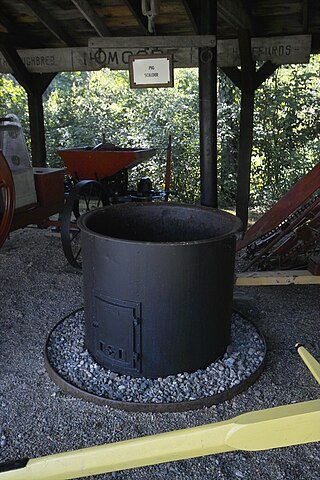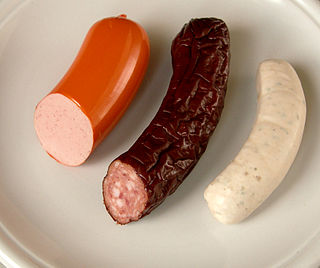Related Research Articles

A kitchen is a room or part of a room used for cooking and food preparation in a dwelling or in a commercial establishment. A modern middle-class residential kitchen is typically equipped with a stove, a sink with hot and cold running water, a refrigerator, and worktops and kitchen cabinets arranged according to a modular design. Many households have a microwave oven, a dishwasher, and other electric appliances. The main functions of a kitchen are to store, prepare and cook food. The room or area may also be used for dining, entertaining and laundry. The design and construction of kitchens is a huge market all over the world.
Liebeck v. McDonald's Restaurants, also known as the McDonald's coffee case and the hot coffee lawsuit, was a highly publicized 1994 product liability lawsuit in the United States against the McDonald's restaurant chain.

A larder is a cool area for storing food prior to use. Originally, it was where raw meat was larded—covered in fat—to be preserved. By the 18th century, the term had expanded: at that point, a dry larder was where bread, pastry, milk, butter, or cooked meats were stored. Larders were commonplace in houses before the widespread use of the refrigerator.
A royal household or imperial household is the residence and administrative headquarters in ancient and post-classical monarchies, and papal household for popes, and formed the basis for the general government of the country as well as providing for the needs of the sovereign and their relations. It was the core of the royal court, though this included many courtiers who were not directly employed by the monarch as part of the household.

Scalding is a form of thermal burn resulting from heated fluids such as boiling water or steam. Most scalds are considered first- or second-degree burns, but third-degree burns can result, especially with prolonged contact. The term is from the Latin word calidus, meaning hot.
The still room is a distillery room found in most great houses, castles or large establishments throughout Europe dating back at least to medieval times.

Café con leche is a coffee beverage common throughout Spain and Latin America consisting of strong coffee mixed with scalded milk in approximately equal amounts. The amount of milk can be higher in a café con leche en vaso or a café con leche de desayuno. Cuban and Puerto Rican establishments often prepare the drink with sugar. Sugar or sweetener is added to taste. It is similar to the Italian caffè latte and the French café au lait.

Get Up and Bar the Door is a medieval Scots ballad about a battle of wills between a husband and wife. It is Child ballad 275. According to Child, it was first published by David Herd.

A pig scalder is a tool that is used to soften the skin of a pig after it has been killed, to remove the hair from its skin. Because people rarely slaughter and process their own pigs any more, pig scalders are seldom used domestically.
Scalded milk is dairy milk that has been heated to 83 °C (181 °F). At this temperature, bacteria are killed, enzymes in the milk are destroyed, and many of the proteins are denatured. Since most milk sold today is pasteurized, which accomplishes the first two goals, milk is typically scalded to increase its temperature, or to change the consistency or other cooking interactions due to the denaturing of proteins.

A thermostatic mixing valve (TMV) is a valve that blends hot water with cold water to ensure constant, safe shower and bath outlet temperatures, preventing scalding.
A saucery was the office in a medieval household responsible for sauces, as well as the room in which the preparation of sauces took place. It was headed by a saucerer. The office was subordinated to the kitchen, and existed as a separate office only in larger households. It was closely connected with other offices of the kitchen, such as the spicery and the scullery. The term is largely obsolete today.
A spicery was the office in a medieval or Renaissance household responsible for spices, as well as the room in which the spices were kept. It was headed by a spicerer. The office was subordinated to the kitchen or the wardrobe, and existed as a separate office only in larger households. It was closely connected with other offices of the kitchen, such as the saucery and the scullery. The term is largely obsolete today, and if used at all is more often simply a synonym for spices.
A chandlery was originally the office in a wealthy medieval household responsible for wax and candles, as well as the room in which the candles were kept. It could be headed by a chandler. The office was subordinated to the kitchen, and only existed as a separate office in larger households.
A poultry was the office in a medieval household responsible for the purchase and preparation of poultry, as well as the room in which the poultry was stored.

Sun scald is the freezing of bark following high temperatures in the winter season, resulting in permanent visible damage to bark. Fruits may also be damaged. In the northern hemisphere, it is also called southwest injury.
A thermal burn is a type of burn resulting from making contact with heated objects, such as boiling water, steam, hot cooking oil, fire, and hot objects. Scalds are the most common type of thermal burn suffered by children, but for adults thermal burns are most commonly caused by fire. Burns are generally classified from first degree up to fourth degree, but the American Burn Association (ABA) has categorized thermal burns as minor, moderate, and major, based almost solely on the depth and size of the burn.
Walnut Grove, also known as Robeson Plantation, is a historic plantation house complex and national historic district located near Tar Heel, Bladen County, North Carolina. The house was built about 1855, and is a two-story, frame house, five bays wide and four bays deep, in the Greek Revival style. The front and rear facades feature three bay double porches. Also on the property are the contributing dining dependency, kitchen, dairy, smokehouse, barn, well, cold frame, and scalding vat.

Brühwurst is the collective name for several types of sausages according to the German classification. They are a cooked sausage that are scalded (parboiled), as opposed to being raw. They are typically prepared from raw meat that is finely chopped, are sometimes smoked, and are typically served hot.

On 23 October 2016, a five-year-old boy was pronounced dead at a children's hospital in Singapore. He was found to have been a victim of child abuse by his parents Azlin binte Arujunah and Ridzuan bin Mega Abdul Rahman for months leading up to his death. This involved both Azlin and Ridzuan using boiling hot water to scald the boy on several occasions, inflicting severe burns and scald injuries which caused the boy to die in hospital weeks after the first of the four scalding incidents. The couple was later arrested and charged with murder. To protect his surviving siblings' identities and their privacy, the boy was not named in the media.
References
- ↑ Woolgar, C. M. (1999). The Great Household in Late Medieval England. New Haven and London: Yale University Press. p. 144. ISBN 0-300-07687-8.